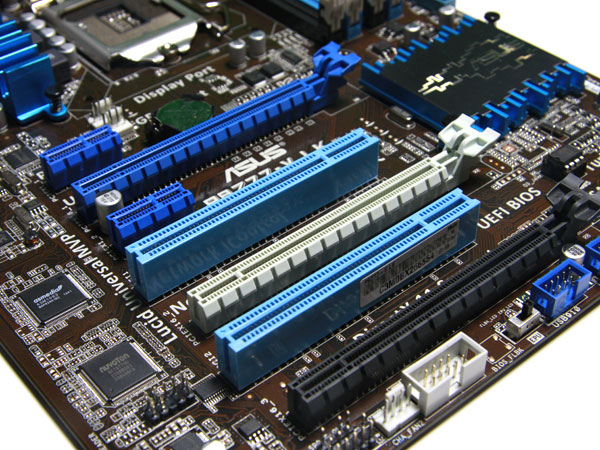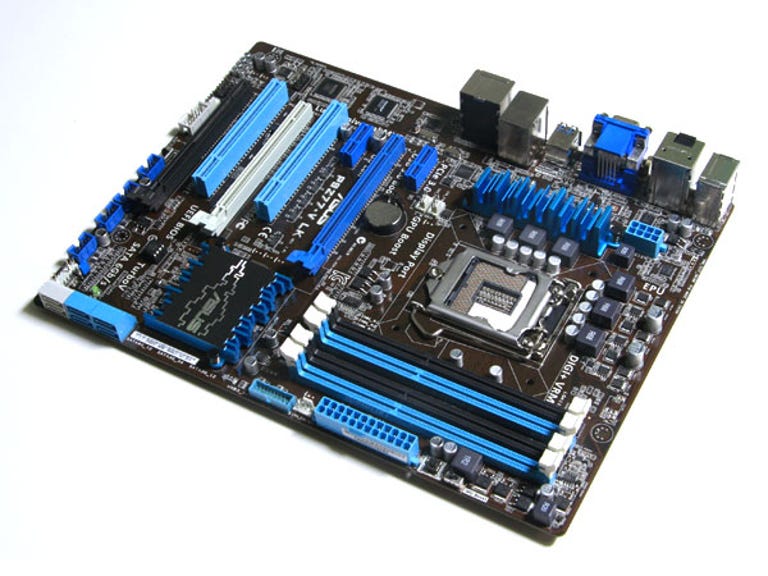 Why You Can Trust CNET
Why You Can Trust CNET Asus P8Z77-V LK review: Asus P8Z77-V LK
An excellent value board, the P8Z77-V LK has been sniped by a more flexible competitor in the same price ball-park.
Allow us to introduce Bob. Bob's real name is the Asus' P8Z77-V LK, but Bob is significantly easier to remember.
The Good
The Bad
The Bottom Line
Connectivity
- Web page: Asus
- Form factor: ATX (305x224mm)
- Chipset: Intel Z77
- External USB: 2 x 3.0 (Intel), 2 x 3.0 (Asmedia 1042), 2 x USB 2.0
- Internal USB: 8 x 2.0, 2 x 3.0
- SATA 6Gbps: 2 x Intel
- SATA 3Gbps: 4 x Intel
- PCI-E: x16: 1 | x8: 1 | x4: 1 | x1: 2
- PCI: 2
- E-SATA: None
- Video: DVI, VGA, HDMI, DisplayPort
- Audio: TOSLink, 7.1 Realtek ALC892
- Ethernet: 1Gbps Realtek RTL8111F
Bob is an entry-level to mid-range board, as is evidenced by its brown colour, which we swear was left back in the 90s, along with green.
At the price Bob is going for, some of the trappings of civilisation have been stripped. There's no push button for power, reset or CMOS clear, for instance.
You do get a MemOK! button, which attempts to auto-configure the motherboard for potential memory incompatibilities, and a physical switch for GPU Boost, which overclocks the integrated GPU in real time. There's another physical switch for EPU (Energy Processing Unit), which detects power requirements of your components and attempts to minimise draw. It's likely to have minimal impact on your yearly bill, but every little bit helps.
You'll still need to clear Bob's CMOS using a jumper, which isn't marked in any fashion on the board. It is the only visible jumper on the board, but throwing noobies a bone outside of the manual is always welcome.
Playing slots like Vegas
There's three physical PCI-E x16 slots along the board, although, in these days of limited bandwidth, these are rated electrically at PCI-E 3.0 x16, PCI-E 3.0 x8 and PCI-E 2.0 x4 the further you get away from the CPU. If you use the x8 slot, then your x16 slot will drop to x8 speed as well.
For all but the hardest of the hardcore, this isn't even remotely an issue. PCI-E 3.0 at x8 provides plenty of bandwidth, even if you're running a dual graphics card set-up.

Most people will be fine with the slot complement.
(Credit: Craig Simms/CNET)
Since Bob sits at the lower end of the economic chain, there's a pair of PCI-E 2.0 x1 ports and a pair of legacy PCI ports, controlled by the ASMedia 1083 for the long-cycle upgrade crowd.
Port port port port
Now make like Missy Elliot, put your thang down, flip it and reverse it. You'll find four USB 3.0 ports here: two the requisite Intel, two from an ASMedia 1042 chip. As you may have guessed from the name, ASMedia is an Asus subsidiary. This doesn't give it exclusive hold over ASMedia chips; EVGA's certifiably insane Classified SR-X uses the very same controller for its USB 3.0 ports.
The Intel USB ports are situated to the left of the Ethernet port — useful information, as the ASMedia ports won't work until you've installed drivers for them. The Ethernet port runs off Realtek's RTL8111F and is gigabit capable.
There's also two USB 2.0 ports, a split PS/2 port for when Things Go Horribly Horribly Wrong, and a picnic basket of video ports — DVI, VGA, HDMI and DisplayPort. Audio is provided by the Realtek's ALC892; it gives you six 3.5mm jacks to play with and TOSLink.
A ridiculous 16 extra USB 2.0 ports can be added, thanks to internal motherboard headers, and another two Intel powered USB 3.0 ports in the same fashion. There's even a header for a serial port, but don't expect Asus to bundle any of the accessories required to make use of these headers — that much is up to you.
Misspelling is EZ
While more limited, Bob's UEFI definitely provides a more polished experience than Gigabyte or Intel, with mouse movement, in particular, being smooth yet responsive.
On the default "EZ mode" screen, you can change boot priority by dragging and dropping drives, and select from one of three performance modes: Power Saving, Normal and Asus Optimal. It also gives voltage, fan speed and CPU temperature readouts. It won't tell you what graphics card is plugged in, what PCI-E slots are occupied or show a graphical representation of what drives are plugged into what SATA slots.
Flip to Advanced mode and you get something more reminiscent of the old BIOS days, with keyboard-controllable entries and, happily, most entries you can change by pressing the Enter key, then choosing from a list (others require you to use the + and - keys or enter a number directly). The feature set here gives some basic overclocking options and a surprising amount of voltage control for an entry level board (giving 0.005V increments in each circumstance). Don't expect the direct voltage measurement points found on Gigabyte's Z77X-UD3H — Asus keeps that sort of feature for its Republic of Gamers boards.
Softer things
Worthy of a mention is Asus' software. Rather than bundle a series of disparate utilities, the company has managed to bundle them all together into something called AI Suite II, which works rather well.
Asus' software bundle is quite well designed.
(Screenshot by Craig Simms)
Among other things, firmware updating is built in here. Maybe it's our region of the world, but we can't ever remember Asus' firmware updater successfully downloading new firmware to install — we've always had to download it through the website first, then flash locally. Nothing has changed on that front here.
There's also overclocking and monitoring options here, should you choose to play with overclocking. If you don't want to tweak manually, there's also a big fat button on it that says "Auto Tuning", which makes the acoustic profile of Bob's fans sound like T-Pain.
We kid, although that would be amusing for all of two seconds. Instead, it gives you access to "Fast" and "Extreme" auto overclocking profiles for your CPU, integrated GPU and RAM. Restarting the machine as many times as is necessary to score the best overclock it can.
Chin scratching
So, we've established that Bob is quite the decent little entry level board, with a cracking UEFI set up and some rather spiffy software.
For a whole AU$10 more, though, we're going to recommend Gigabyte's UD3H instead. Thanks to the extra flexibility brought by its physical power buttons, mSATA slot, extra USB 3.0 ports and, if we're vain aesthetes, the nicer black board, we feel it's a better choice for the entry-to-mid-range crowd.


